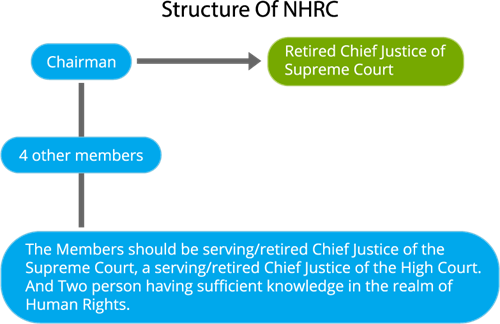PDF chapter test TRY NOW
UN and Human Rights:
The United Nations, right from its inception, has been functioning as the torchbearer of human rights across the world. The United Nations has six important organs which enable the smooth functioning of the international organisation.
These organs are assigned to look after different categories of issues around the world and are expected to come up with solutions to pressing problems.
ECOSOC: Expanded as the Economic and Social Council, is one among the principal organs of the UN, which is responsible for the coordination of social, economic and humanitarian activities of the UN. It was established in the year \(1945\), and its membership is based on geographical representation.
Human Rights Commission in India:
According to the Charter of the UN and UDHR, every country is obliged to set up separate commissions to look after the issue of human rights in their countries. In India, there are two commissions one for the Nation and the other one is for states.
The detailed structure, functions and powers of the human rights commission are discussed below.
The National Human Rights Commission (NHRC):
1. The National Human Rights Commission is a “Statutory body” (One created by law). It came into existence after the enactment of the “Protection of Human Rights act” on October \(12\), \(1993\).
2. The NHRC of India is considered the apex institution that takes action against the breach of Human Rights in the country and has earned the sobriquet “Watchdog of Human Rights” in India.
Structure of the Institution:

Delhi: The office of the National Human Rights Commission is located in the capital city of Delhi. The President appoints the Chairman and members of the NHRC.
1. The Commission is empowered to take “Suo-Moto” actions (Actions on its own) without receiving a formal complaint/allegation.
2. The Members of the commission are appointed by the President for \(5\) years or up to the age of \(70\) years.
3. The NHRC contains deemed members from the “National Commission of Minorities, SC, ST and Women”.
Divisions of NHRC:
1. Administrative division
2. Law division
3. Investigative division
4. Policy and research program division
5. Training division
Functions of the NHRC:
1. To inquire into any negligence and violation of human rights in the prevention of such violations by a public servant.
2. To visit the detention places and study the living conditions of the inmates and recommend for the betterment of their condition.
3. To intervene in any proceedings of the court regarding human rights violation.

National Human Rights
4. To study international treaties and other documents on human rights and incorporate those in their recommendations.
5. To promote and proliferate the principles of human rights among the masses.
6. Encouraging the activities of Non-Governmental organisations in the field of human rights.
The State Human Rights Commission (SHRC):
The Provisions of the “Protection of Human rights act \(1993\)” enables for the establishment of the Human rights commission in a State under Section \(21\).
Currently, the Institution of SHRC is seen in \(26\) States of India. The Commission inquires about the violation of subjects in the State List and the Concurrent List.
SHRC: In Tamil Nadu, the State Human Rights Commission was established in April \(17\), \(1997\).
The members and the Chairperson of the Commission are appointed by the Governor of the State but are removed only by the President.
Structure of the Commission:

Functions of the Commission:
To inquire into any negligence and violation of human rights in the prevention of such violations in matters present in Concurrent and the State list.
Concurrent List: The list contains subjects/ items in which both the Central and the state governments have equal powers to legislate.
Most of the functions of the Commission are very similar to the National commission but are highly confined to the state list.
It can recommend the state government or an authority to pay compensation for the damages of the victim.
The Commission has the powers of the Civil Court, and its proceedings have a judicial character.
